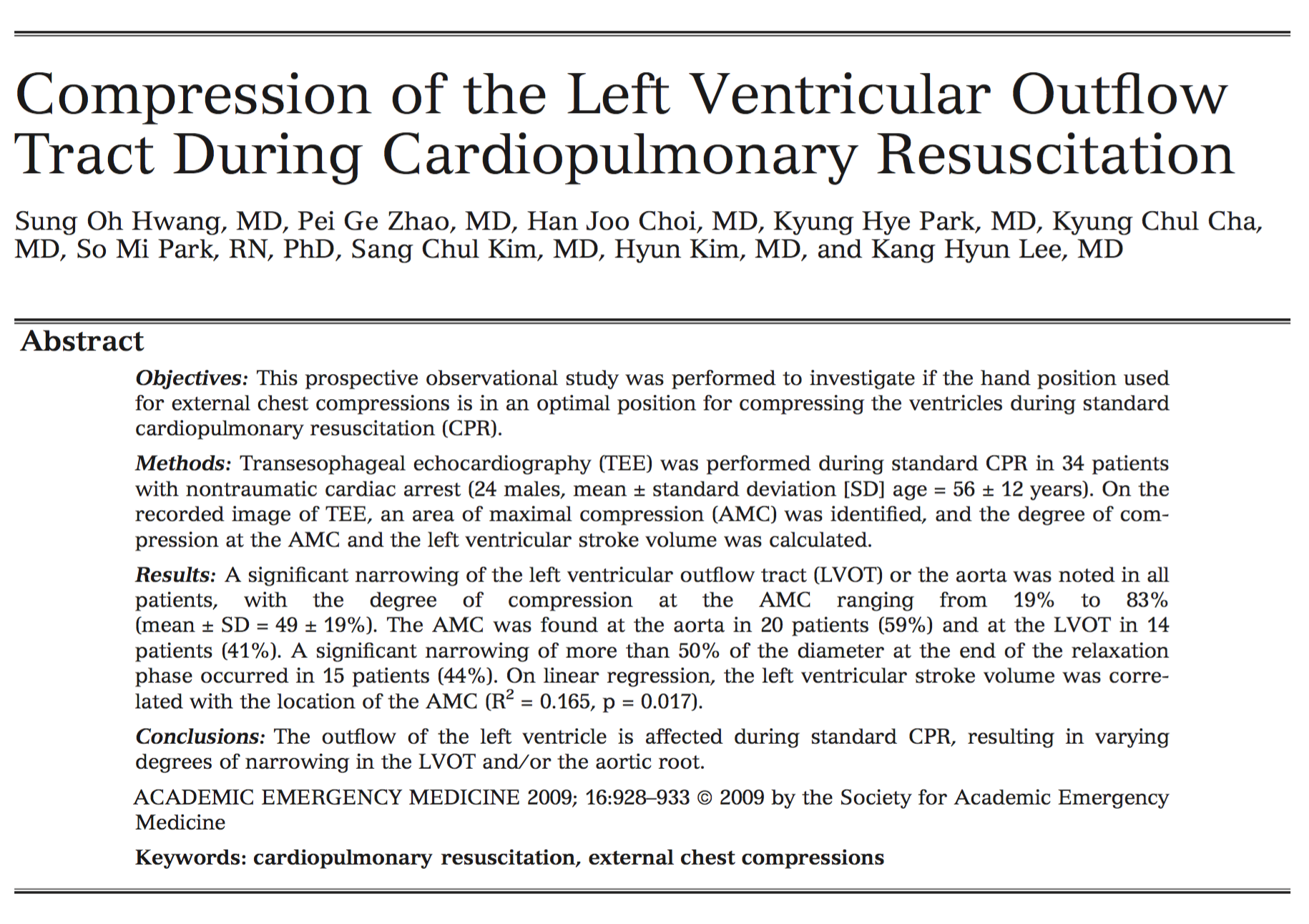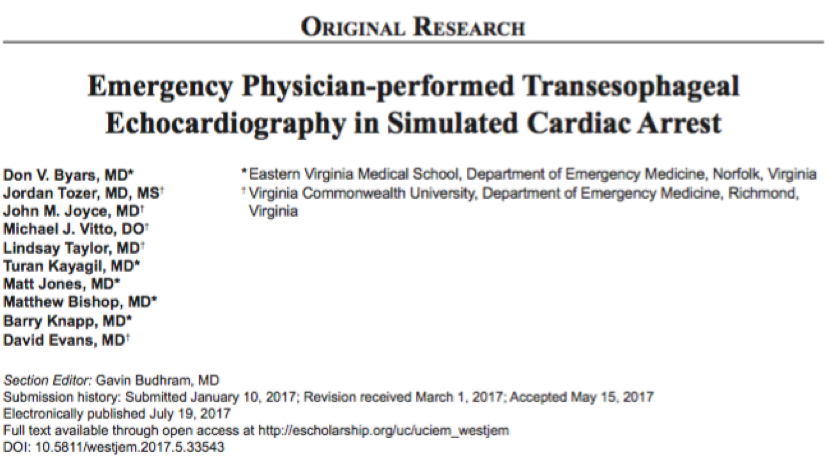EVIDENCE & SELECTED LITERATURE
EVIDENCE ON RESUSCITATIVE TEE
Several studies have demonstrated the feasibility to train emergency physicians and intensivists to use TEE at the point-of-care, and recognized its potential to enhance echocardiographic examination and improve decision making in critically ill patients, in the ICU and Emergency Department settings.
The following articles are a selection of published literature relevant to the performance of resuscitative TEE.
State-of-the-Art Review TEE in Cardiac Arrest JACC
narrative review by an INTERDISCIPLINARY group of field experts discussing the rationale, supporting evidence, opportunities, and challenges, and proposing a research agenda for the use of focused TEE in cardiac arrest with the goal to improve resuscitation outcomes.
Impact of Critical Care TEE in ICU JICM
RETROSPECTIVE STUDY. Consecutive critical care TEE studies on ICU patients were reviewed. Examination details, including indications, complications, examination complexity (number of views, Doppler techniques), and clinical recommendations were aggregated and analyzed. Two hundred seventy-four TEE studies were performed by 38 operators ARE REPORTED.
Transesophageal Ultrasound (TELUS) CJA
Transesophageal lung ultrasonography (TELU: a complete description of the technique by summarizing the existing literature and describing experience that extrapolates from transthoracic lung ultrasonography.
ED TEE in the evaluation of Blunt Aortic Injuries JEM
case series that illustrate the diagnostic value of emergency physician-performed resuscitative TEE in the diagnosis of BLUNT traumatic aortic injuries (BTAI) in patients presenting with blunt thoracic trauma. As the use of point-of-care TEE during resuscitation continues to expand in emergency medicine, the evaluation of patients with BTAI represents a novel application where this emerging modality can allow early diagnosis of these injuries in hemodynamically unstable patients.
Review TEE in Cardiac Arrest Resuscitation JUM
review EVALUATING the use of resuscitative TEE in operating rooms, emergency departments, and TEE used in other settings. In many cases, TEE changed the direction of the resuscitation; however, it is unclear whether TEE changed patient-oriented outcomes, such as neurologically intact survival. Few adverse events related to TEE have been documented. There is growing evidence that physicians can learn to use TEE during resuscitations and apply the findings to clinical decisions.
Multicenter Resuscitative TEE Study (rTEECoRE) - Annals EM 2024
a prospective, multicenter study involving adult critically ill patients in whom focused TEE was performed for evaluation of cardiac arrest, undifferentiated shock, hemodynamic monitoring, and/or procedural guidance in the ED, ICU, or operating room setting.
Critical Care TEE During COVID-19 Pandemic JASE
A multidisciplinary (intensive care, critical care cardiology, and emergency medicine) group of experts in point-of-care echocardiography and TEE from the United States and Canada convened to review the available evidence, share experiences, and produce a consensus statement aiming to provide clinicians with a framework to maximize the safety of patients and healthcare providers when considering focused point-of-care TEE in critically ill patients during the COVID-19 pandemic.
Emergency Pacemaker Guidance ED TEE AJEM
This case report describes a patient with extensive cardiac history who presented after a witnessed arrest, and after return of spontaneous circulation, sustained an unstable bradycardia requiring emergent transvenous pacer placement while in the ED. A temporary pacer wire was placed transvenously without successful capture. Transesophageal echocardiography was then utilized to guide and adjust the pacer wire placement helping to successfully achieve capture.
Prospective Study TEE in OHCA - LVOT Compression
prospective observational study performed to investigate if the hand position used for external chest compressions is in an optimal position for compressing the ventricles during standard cardiopulmonary resuscitation (CPR). tee was performed during standard CPR in 34 patients with nontraumatic cardiac arrest. On the recorded image of TEE, an area of maximal compression (AMC) was identified, and the degree of compression at the AMC and the left ventricular stroke volume was calculated.
Review Cardiopulmonary US and TEE in ED
Resuscitative ultrasound describes point-of-care applications that provide diagnostic information, physiologic monitoring, and procedural guidance in critically ill patients. This article reviews the evaluation of ventricular function, identification of pericardial effusion and tamponade, evaluation of preload and fluid responsiveness, and hemodynamic monitoring, as some of the main applications where this modality can help emergency physicians during resuscitation of critically ill patients.
Prospective Study ED TEE in OHCA - Resuscitation
prospective observational study consisting of a convenience sample of adult patients with OHCA. TEE was performed by emergency physicians following intubation. Images and clinical data were analyzed. TEE was used intra-arrest in order to assist in diagnosis, assess cardiac activity and determine CPR quality by assessing area of maximal compression (AMC), using a 4 view protocol.
Retrospective Study TEE OHCA Resuscitation
Retrospective cohort study. TRANSESOPHAGEAL assessment of right ventricular fractional area change, right ventricular outflow tract fractional shortening, left ventricular volumes, ejection fraction, and aortic diameters were performed in refractory out-of-hospital cardiac arrest patients admitted to emergency department for extracorporeal CPR
Retrospective Study TEE OHCA - CPR Pauses
RETROSPECTIVE study To assessing the benefit of transesophageal echocardiography in SHORTENING cpr pauses. compared the duration of chest compression pauses between tee, tte, and manual pulse checks on video recordings of cardiac arrest resuscitations. analyzed 139 pulse check CPR pauses among 25 patients during cardiac arrest.
Review Focused TEE in ED-ICU CHEST
This article introduces the workings of the TEE transducer, presents a systematic approach to a goal-directed hemodynamic assessment, and includes a series of illustrative figures and narrated video presentations to demonstrate the techniques described.
SVC evaluation with TEE Fluid Responsiveness
prospective Icu study evaluating svc diameter measured with transesophageal echocardiography in mechanically ventilated patients to determine the prognostic value for fluid RESPONSIVENESS
Blaivas Case Series (Cardiac Arrest)
The first publication and arguably one of the most important papers, is this case series published in resuscitation in 2008 by Michael Blaivas.
In this case series Dr. Blaivas reports the first experience of an emergency physician - performed TEEs using a focused protocol specifically in cardiac arrest patients.
These cases were selected from among 15 TEE resuscitation cases occurring over a 6-month period at a large tertiary care emergency department.
Sim-Based TEE Training is feasible
Building on the experience reported by Blaivas, several years later in 2015 Robert Artnfield and colleagues from Western University in London Ontario, Canada, reported their single center experience, conducting brief and focused TEE training on a group of 14 emergency physicians.
In this study they report that following a 4-hour didactic and simulation based workshop, these physicians were able to adequately obtain and interpret TEE views and acceptable retention of this skill at 6 weeks. Of course, there are several limitations to this study, but it was the first report describing the feasibility to train providers in this focused protocol with a simulation based workshop.
First TEE ED Program (Canada) Description
The third study, is the second publication from the same group published in the Journal of Emergency Medicine in 2016.
This was a retrospective review of all ED TEE examinations carried out between 2013 and 2015 at their institution.
The most common indications for TEE were intra-cardiac arrest care in 43%, post-arrest management in 26%, and undifferentiated hypotension in 40%.
TEE imparted a diagnostic influence in 78% of cases and impacted therapeutic decisions in 67% of cases.
Rol of TEE during ECMO cannulation (ECLS)
The next study, was a brief report from the group at University of Utah. In this study they describe their group’s experience of first 12 cases of ECLS, (Extracorporeal Life Support) which involves placing selected patients on ECMO during cardiac arrest resuscitation as a bridge to immediate survival. This is relevant to those performing TEE in emergency medicine because TEE was an integral part of the cannulation process. In 10 of the 12 cases, emergency physicians performing TEE were able to confirm the location of venous and arterial guidewires before moving to dilation and cannulation phase.
Many other centers performing ECMO in cardiac arrest are using TEE as integral part of their programs.
Sim-Based training is feasible #2
Another simulation based prospective educational cohort conducted by a group at VCU in Richmond, Virginia. In this study, following a didactic lecture, 40 emergency medicine residents underwent 3 simulation based training sessions over the course of 3 consecutive weeks, followed by an individual simulation-based assessment to test the residents ability to develop and interpret both normal views, as well as some of the most common findings seen in cardiac arrest (such as tamponade, fine ventricular fibrillation or asystole). This study showed that EM residents can rapidly perform TEE studies in a simulated cardiac arrest environment with a high degree of precision and accuracy.
ACEP Policy Focused TEE in the ED (2023)
The American College of Emergency Physicians (ACEP) has recently published a Policy Statement titled Guidelines for the use of Transesophageal Echocardiography in the ED for Cardiac Arrest. In this guideline, the objectives and limitations for focused TEE in cardiac arrest are described, and general guidance is provided regarding qualifications and responsibilities of clinicians performing examinations, as well as documentation, equipment, safety and quality control.




















